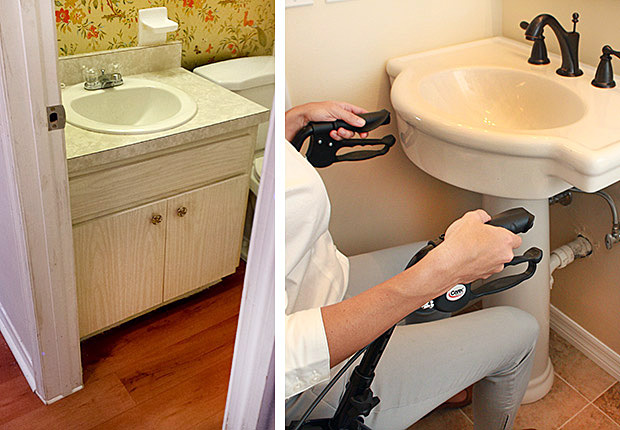AARP Hearing Center

It has been said that Lyndon Baines Johnson – LBJ - the thirty-sixth POTUS, gave monogrammed electric toothbrushes to White House staffers so they would be reminded of him the first thing in the morning and the last thing at night
Goes to show how important toothbrushing can be.
While it was politically important to LBJ, it was – and is – existentially important to RJW (that’s me.) But it's been a long and winding road. (TL&WR)
As a result of my disabling motor vehicle accident in 2005, my arms and hands lost their functionality; my left arm hung motionless, my right arm had partial movement; both hands had fingers that were inflexibly curved - no giving the finger to anyone, no typing blogs without the help of a fabricated finger prosthetic, and no toothbrushing.
But I was determined to straighten the winding road – although the first steps were wobbly.
The uncoiling of the road began in the Skilled Nursing Facility (SNF), in Multnomah City, outside of Portland. My son, Josh, had come up from California to tend to his fragile father. Among the many things I needed was my teeth brushed. So, he went at it.
SNF caregivers gave Josh disposable, Q-tip- like pre-medicated devices – call them “toothbrushes.” Josh stood over me as I slouched in my wheelchair. He rubbed the bristles over a group of teeth. Then he’d throw the “brush” away. He took another “brush” and repeated the maneuver. In “Groundhog Day” fashion, he did it again on another group of teeth. And threw the new “brush” away - again. He repeated the process until all the “toothbrushes” had been used and dumped.
The wonky first step on TL&WR had been taken.
After about five months of Josh-brushing at the SNF, I graduated to the Rehabilitation Institute of Oregon (RIO), located at Legacy Emanuel Hospital in NW Portland. RIO was considered the “boot camp” of rehabilitation. PT, OT, VT began at 7:30 and ended at 4:30, six days a week. Visitors were allowed on Sundays and “campers” could leave the premises.
I practiced ordinary - but extraordinary for me – Activities of Daily Living (ADL), including dressing (which I failed to be able to do.) Among other preparations for fuller rehabilitation I practiced were: walking with a four tip cane, climbing a three step set of stairs, lying down in a bed, transferring from wheelchair to toilet seat, getting in a car. Things like that – but no toothbrush loading. I was on my own. DIY.
The first step in solo brushing was to loosen the cap of the tooth paste. I did this by twisting the cap in my teeth. Second, I laid the tube on the sink counter, and, since I had no movement of my left arm or fingers, I laid my left elbow gently on the tube. I placed the toothbrush on the right side of the counter, then pressed on my elbow to start the oozing toothpaste to grudgingly emerge from the tube. As it was slithering out, I slid the toothbrush toward the tube with my right hand to catch the snaking paste on the bristles of the brush. In a moment of triumph, I swept the bristle to my mouth. I had brushed. All by myself. Hooray!
Now-a-days, fifteen years later, toothbrushing remains complex, but less elaborate.
In fact, at the start of my life at the ALF, I abandoned my RIO strategy and hard work. Brush Your Own Teeth (BYOT) was laid to rest.
As an ALF newbie, toothbrushing preparation was out of my hands – literally. Readying my tooth brush was one of the many tasks of the caregiver. She squeezed --from the bottom of the tube please -- the paste onto the bristles. I let her do it. Despite my success at RIO, I was lazy. Allowing the caregiver access to paste and bristle added points to other assists provided by the caregiver. It cost me more to live here. “What the hell!” I thought. It’s only a few points, and hardly makes a dent in the $4700 per month that it costs me to live here. (It costs almost twice as much now.)
But now it’s in my hands again.
I wheel up to the sink counter. That’s difficult right at the get go. The counter/sink is not construed to ADA specifications. Wouldn’t the engineers think that in an ALF there’d be persons in wheelchairs? The counter is too high. I have to sit breast height and lean upward into the counter. (I’m glad I’m the gender I am.)
The toothpaste tube and toothbrush stand at attention in a 12-ounce glass. I lift out the brush with my right hand and insert it between the thumb and immovable index finger of my left hand. With my right hand, I lift the tube out of the glass and put it at the bottom of my chin - trying to avoid the paste oozing onto my beard - and push the cap open. (Technological progress – now there’s a flip top cap )
Once that feat is accomplished, I slide my hand down the tube and squeeze. Simultaneously, I move the brush in my left hand close to the tube to receive the squishy stuff. Both hands are full - the brush in my left hand, the open tube in my right. I close the cap – again with my chin – and reinsert the tube in the glass.
Finally, with my free right hand, I take the brush from its temporary resting place between left thumb and index finger, and brush.
I’ve proven to myself, with both hands disabled, I can brush my teeth by myself. BMOT
Cavity free. Breath, minty fresh. My tooth brushing self-sufficiency firmly established. I believe in myself.
TL&WR is finally straight.
Dick Weinman is an AARP Oregon volunteer, our Assisted Living Guru and author of this series called The Thin Edge of Dignity.































































